Warning: Lots of water.

We arrived at the Iron Range rainforest just over two weeks ago after seven months at Moreton. Our leaving from Moreton turned out to be a drawn out affair due to a largely unexpected late ‘last hurrah’ of the wet season. This is life on the Cape – the weather rules – either you roll with it, or you ….. you just have to roll with it, there is no other choice. It can (& did) feel a bit frustrating at the time, but really it is the raw wildness & lack of southern civility which defines places like Cape York and for those of us with a sense of adventure, it’s part of the attraction.
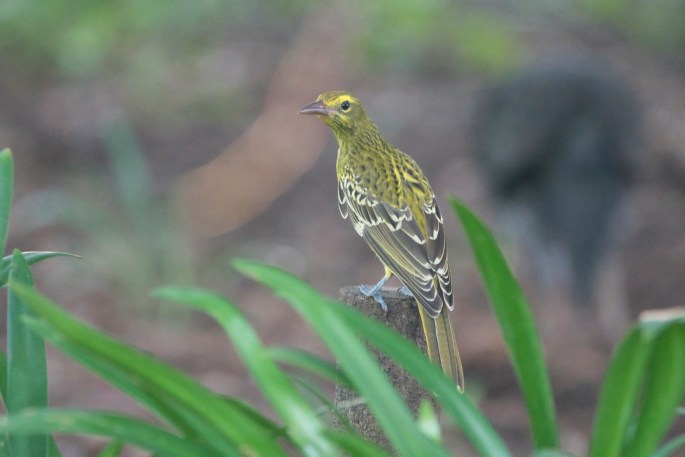
At the end of our last blog we were around half way through our time at Moreton, we had become accustomed to being largely on our own there, the regular routines to keep the place ticking over were established & time was measured by regular weekly events. We were enjoying ourselves, but beginning to think that our wet season jinx was at work again, whilst folk down south were struggling with flooding like never before. It was hard to say we were looking forward to the very same thing which had affected so many so badly, taking everything from some. A few folk from overseas were concerned we might be caught up in those floods not realising we were several thousand kilometres away from the affected areas they were seeing on their TV screens. The reality is that Cape York has evolved to naturally cope with flooding every wet season. It is a normal & replenishing process, albeit an exciting one to witness, but we were beginning to think it wasn’t going to happen.
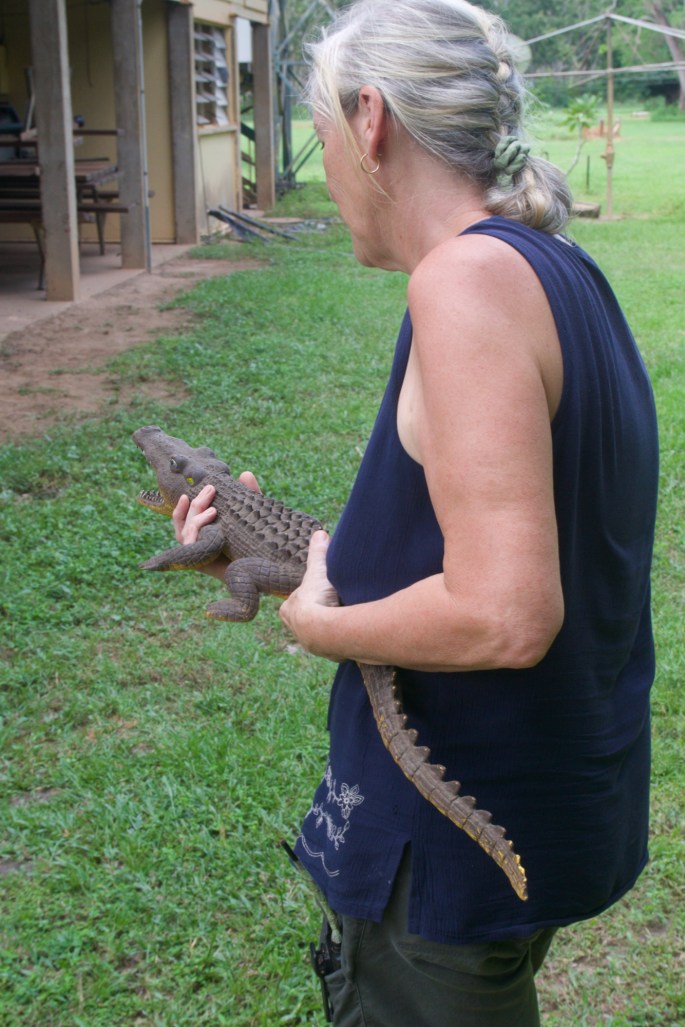
We’d had rain, often *very* heavy, but not for long. Good for filling water tanks, but not regular extended monsoonal falls. Rarely was it worth sheltering from the rain, we just got wet & then dried out again.

By the end of January the country was transformed. No longer the brown dusty grass-floored forests. Now they were thick,lush & green in the places where you could actually see the forest floor. A drive along the road, both north & south revealed huge areas where it was obscured by water sitting under the trees.

On the 29th January the river rose back above 3 metres for the first time in several weeks, despite very modest rainfall totals. The forest floor water slowly finding it’s way to the river over the 150kms of catchment length to our south east. Rain had become less intense but the monsoon trough had dropped south making the ’showers’ longer lasting. Enough for the ground to remain wet on the surface most of the time. Humidity was commonly at 100% and we were wet & sticky. Heavy cloud cover was the norm & we liked it because it was keeping the temperatures down in the low 30’s. On occasions when there was a break in the clouds the sun was harsh. Harsh enough to not dally between areas of shade.
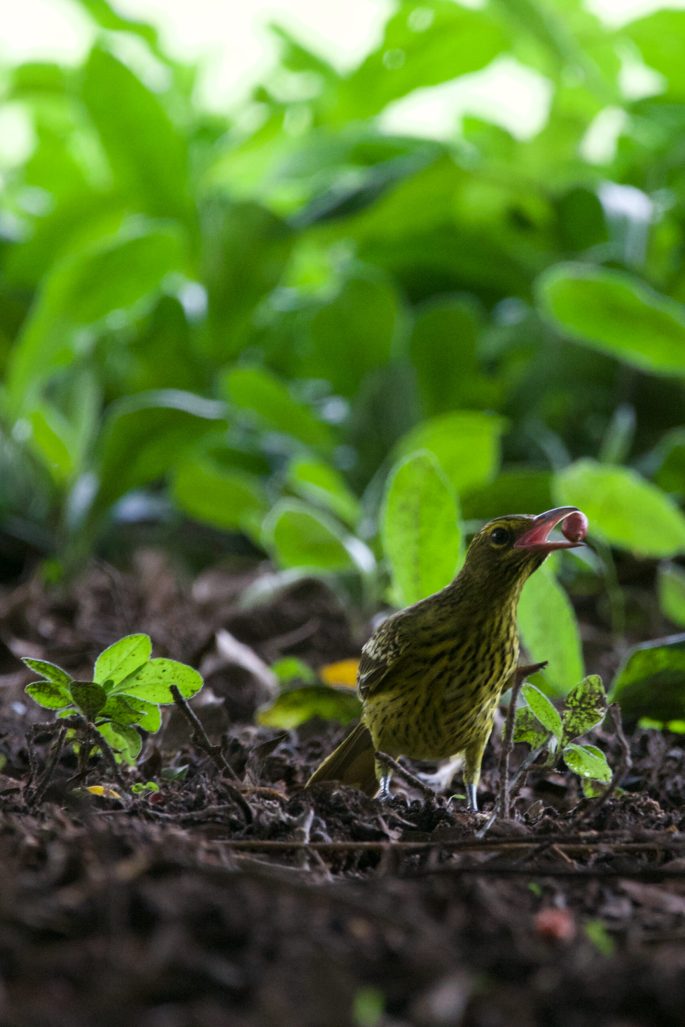
Firefly activity increased at night, they were all through the house twinkling away every night. Kinda warm & fuzzy to have them as housemates.

In early February the river rose, covering the bridge & cutting us off for the first time. We moved all that needed to be moved to high ground & ensured what needed raising off the ground was, & tying up other things to secure them. It seemed odd putting ropes around items too heavy to lift, such as half full 44 gallon drums of oil & 1000 litre IBC’s of diesel, to prevent them floating away, but useful to create a mindset about the potential power of lots of water. The river peaked at 10.97 metres, more than 4 metres of water over the bridge, but nowhere near the almost 16 metre record of past years. The river became far wider. It seemed like one of those things that you think you can imagine beforehand, but until you actually see it the reality of so much water where previously there wasn’t doesn’t hit home. Definitely a high wow factor score! We had been told that at 11 metres the small feeder creek just north east of the property, Drome Creek would back up enough to flood across the road. This was dead accurate, at 10.97m the water was 30mm below the road surface, the forests & roadsides either side of the road became lakes & it was a strange feeling standing on a narrow strip of bitumen just above the water line – ‘a long island’. Other creeks were up too, 15kms north of us Schramm creek had cut the road & Myall Creek , over near Weipa was in full flood preventing anyone getting in or out of Weipa by road.
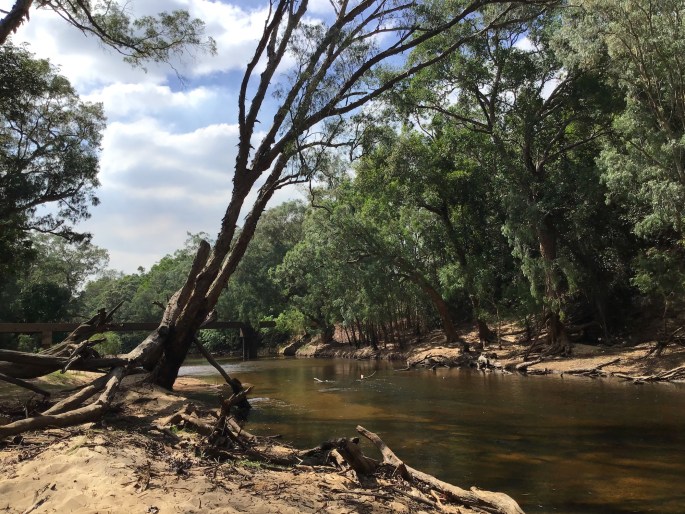

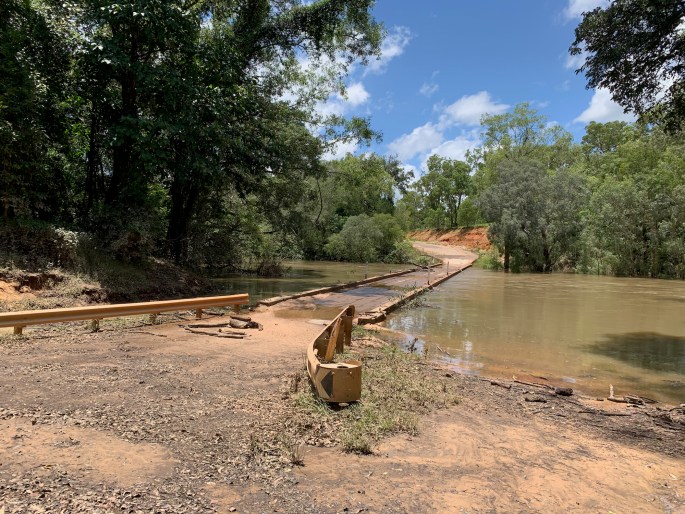
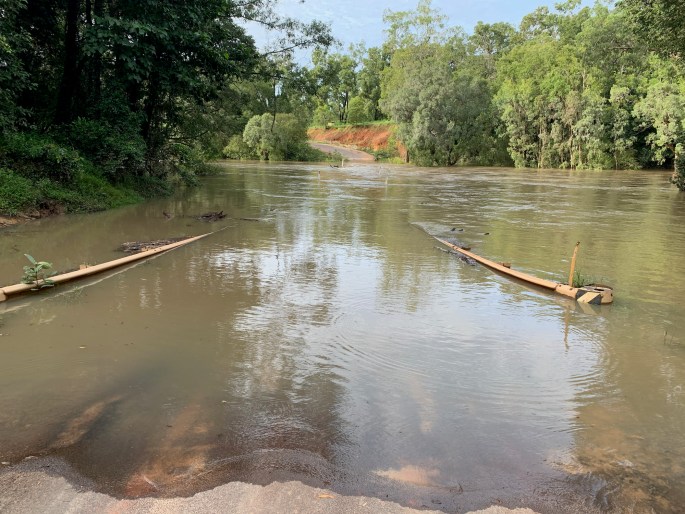

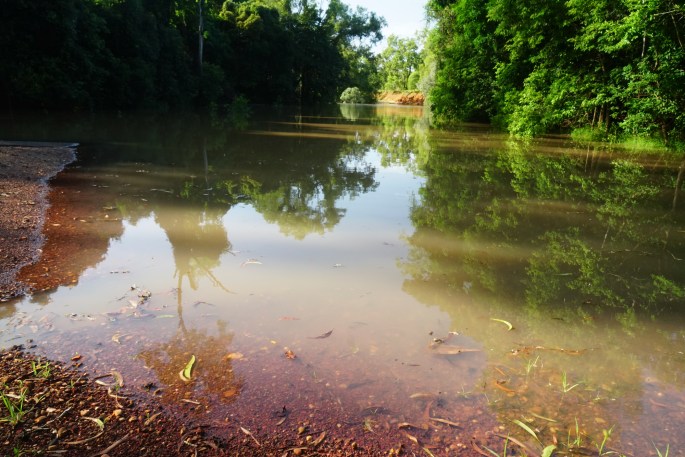
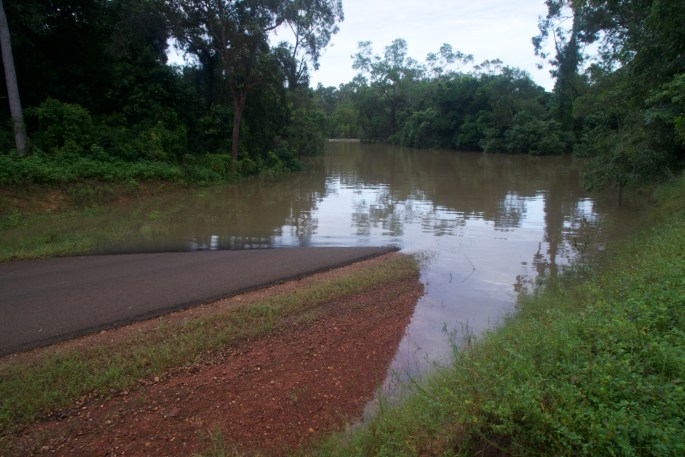

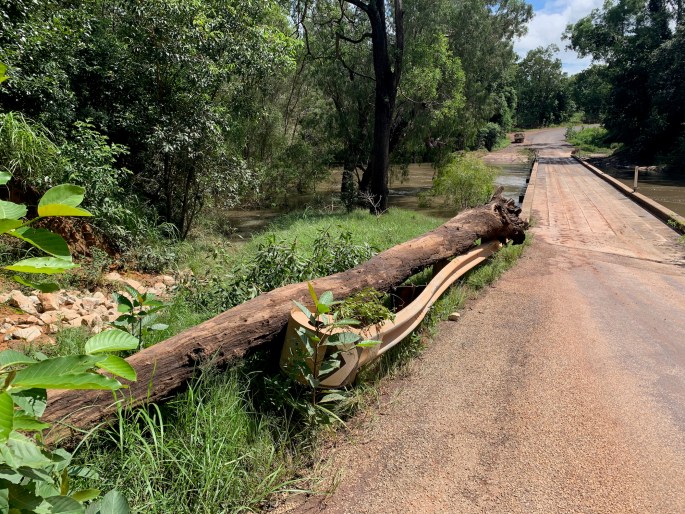
Around this time whilst the water was up an unexpected helicopter passed over one morning, circled low , & then landed in the camping area. Turned out to be a Telstra technician come to check the public phone box just outside the front gate & it’s associated satellite dish close to where the chopper landed. It amused us that a public phone box in such a remote location would receive such expensive attention, but we were to find in the near future that there were a few folk glad to find it in good working order.
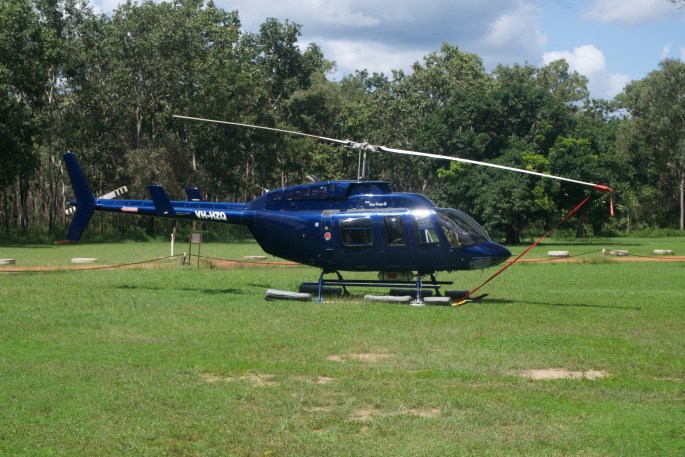
Also around this time our internet went down. To many an occurrence like this might be a nuisance, but for us it meant our connection with the outside world, was all but lost. The saving grace was that we still had a phone, a ‘landline’ which in actual fact worked via satellite, a different satellite to the internet. The problem with satellites whether for internet, TV (& radio) & phones is that they are susceptible to not working in heavy rain or heavy cloud, & there was plenty of that around. Mostly the phone kept working, but often with poor sound quality & dropouts which made it’s use challenging. Luckily we only ever lost 2 of the 3 services at the same time. Without internet tv & radio & only a dodgy phone this was the first & only time we truly felt remote. They were our lifelines we took for granted …. until they weren’t there. Via the owners we were able to get onto an NBN technician in Cairns. He agreed to fly in to sort out the problem, which on the basis of our information, he diagnosed a failed part on the satellite dish (LNB). Trouble was that this was early February & the first likely time he could get to us was going to be more than a month later. He would be in a chartered plane & land on our airstrip. A month without internet felt disastrous! Aside from a complete lack of social media (ha ha) it meant putting in our airstrip reports would be compromised & without those – no weekly mail plane & groceries. More importantly it reduced our options should an emergency situation arise.
As it turned out we were only without internet for a few days. Thankfully we had a ‘Plan B’ available to us. In an adjacent building was an NBN set up previously installed for the use of seasonal staff. Via the phone we spoke with the owners who arranged with the internet provider to switch the service to this other satellite receiver. We used this for a week or so whilst waiting for 70 odd metres of cable to arrive on the next mail plane so that we could rig it up between the buildings & have internet back in the house. The situation was managed well by the owners who understood the essential nature of internet service in a remote area. It worked well until the technician was able to fly in as promised. The sat dish failing (& the previous router which failed just after we moved into the house) were testament to how hard on things the climate up here is. Heat & humidity. Electronics, batteries etc – all have much shortened lives compared to down south.
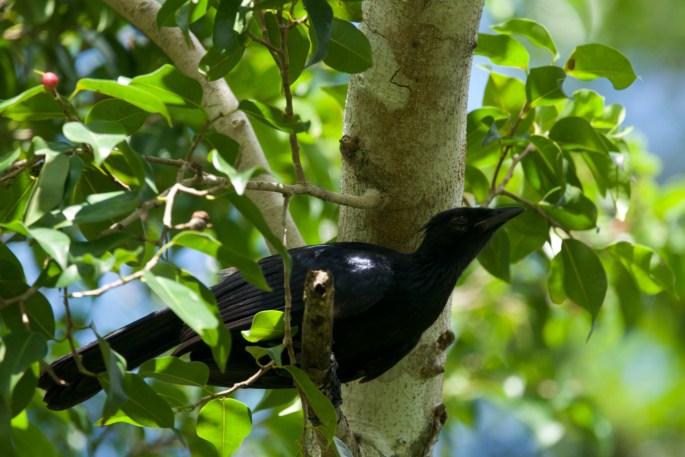
At 1.05am one morning the power went out. Using a CPAP machine to sleep with alerts you to such things instantly! No-one to call to report a power outage. I was it. Had to fix it asap, as much of our food supply depended on the freezers continuing to run, as well as the additional fans aimed at each freezer to help them in the tropical heat. A few choice British words like ‘Bollocks’ were uttered & repeated as I stumbled around in the pitch dark looking for a pair of shorts before what I thought might be divine intervention occurred. The lights came on. For a moment, just a moment, I entertained the impossible notion that the generator had miraculously started itself up again, until I realised that MrsTea had turned on the lights. The 12volt lights running off the battery bank out on the veranda. Damn, why hadn’t I thought of that! So torch in hand, shorts successfully on, I went out to try to fix the generator. Without boring you as to the cause & the fix, suffice it to say I was quite pleased with myself being able to diagnose the fault & fix it within around 30 minutes, cleaned up & back in bed by 2am. A problem solved which gave a degree of satisfaction in addition to a little lost sleep.
The weekly mail plane was another lifeline. Every Wednesday it brought not just mail, but our weekly order of fresh produce. Except sometimes it didnt. Perhaps 30 percent of the time it would cancel, often with late notice. A phone call after we had got back from sitting up at the airstrip waiting for an hour or more. On one occasion we heard it fly overhead, but it didn’t land. 3 weeks consecutively was the longest run without mail , fruit & veg. We did have a backup supply of tinned & frozen to get through, & were very grateful recipients of some veggies, fresh eggs & a loaf of bread from our nearest neighbours at Bertiehaugh Station 40kms up the road, & the nicest sweetest juiciest pineapple from our neighbours over at Wattle Hills (3 hours drive away when the track is passable). On occasions there would be a trainee pilot flying the plane, alongside a regular pilot. Seeing the difference between experience & inexperience landing on known/unknown airstrips gave us an inkling how difficult it must be landing on unknown airstrips each with it’s own idiosyncrasies. And the trainees would be stopping at multiple airstrips on each mail run. Despite the occasional shortcomings of the service (more around communications than the deliveries/non deliveries themselves) it was a very welcome service. A regular(’ish) event to mark each week, and when there was mail it invariably felt like Christmas. Online shopping has transformed life in the bush!
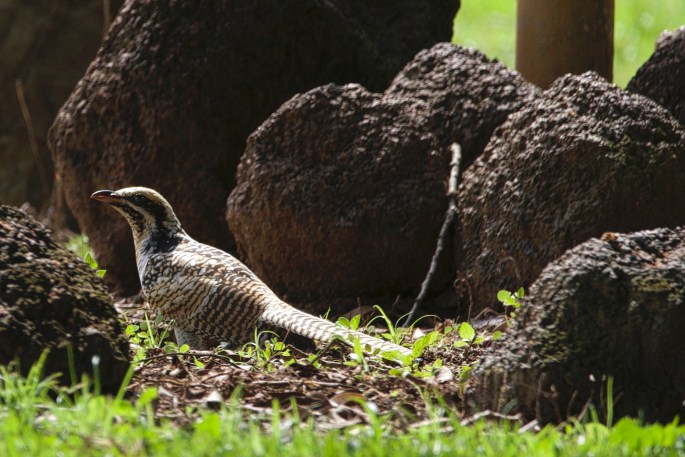
A number of mail plane days were made more ‘interesting’ by the feral cattle. More than a few times we had to listen for the sound of the plane, signalling it’s imminent arrival, & immediately shoot up the airstrip to herd a few errant bulls off the airstrip into the forest, & then sit with the Toyota’s motor running on the edge of the forest to deter them from returning before the plane landed. Once landed, we’d belt back down the airstrip to collect the mail to keep them from waiting too long, advising the pilot to give us a few minutes to get back up to where the cattle were to ‘block’ them from returning to the airstrip during take off. Sometimes we could chase the cattle far enough into the forest to feel secure about them not returning too soon, a while before the plane was due to arrive, but it wasn’t uncommon for them to get just into the trees & stop, turn & look at the car knowing full well we couldn’t follow them in any further. Some had had more contact with humans than others & the ones who hadn’t learned to run away were more bolshy. On occasions taking a run at us. That was when we stopped pushing them through the trees on foot. They were big beasts with impressive looking horns.
We (I) almost missed the plane altogether one morning. I’d gone up to the airstrip alone half an hour before the plane was due, as was the normal practice. Two cows I hadn’t seen before needed chasing off the airstrip, but there was a problem. Whilst they were inside the fence along the roadside, their two calves were outside the fence. Chasing them into the forest on the other side of the strip just wasn’t going to happen.They would circle back around me to get to their calves. Simple, I thought, “I’ll just run them up the fence line to a gate & let them out”. We reached the gate, with calves following their mums along the other side of the fence, but things went awry when I got out of the car to open the gate. One cow stood watching me from a safe distance, the other continued on up the fence line, it’s calf following on the other side of the fence again. Back in the car I left the standing cow hoping she would go through the gate to her calf, & not vice versa. She did, after I had taken off after the second cow, running the car in a wide arc around her to head her back to the gate. By this time I was well beyond the short grass of the airstrip & into grass & tree saplings the height of the bullbar, with a few similar sized termite mounds for added interest. What I had failed to notice though, until I heard it, was that there was sitting water there, about 6” of it on top of what proved to be very slippery & slimey grey clay. By the time I heard the water splashing I was bogged & spinning wheels. “Right o” thinks I, “I’ll lock the hubs in & try out the diff lock for the first time. Did this but it didn’t help…. at all. That’s when I started to worry. The plane was on it’s way, MrsTea was back at the homestead, & I knew that the UHF radio was out of range up here at the far end of the airstrip, so I couldn’t call her to ask her to meet the plane instead. So I’m trying valiantly to get some traction, but getting nowhere, when it dawned on me that only the rear wheels were spinning, & suddenly I had a glimmer of hope. “Yep, you little beauty” I thought. Sure enough when I’d locked the hubs, I hadn’t locked the hubs, I’d unlocked them! They had been left locked from previous use. The best argument to date to always ensure I take my glasses with me wherever I go! With the hubs now locked in, & the diff lock engaged & 4wd engaged I slithered the car this way & that, side to side, but slowly moving toward the edge of the water, which as it turned out was only about 20 metres at most, but it was a long 20 metres! During all these shenanigans the cows had kindly reunited with their offspring on the outside of the fence & all I needed to do was to shut the gate. Phew! After collecting the mail from the plane, & a strong cup of tea, the old Toyota Land Cruiser needed a good pressure washing to remove all the grey clay which probably took longer than it had taken to get me into & out of the bog.
And then came the war in Ukraine. It was, & still is awful as any armed conflict is. It dominated at Moreton for a week or two, fears of World War 3, of nuclear bombs racking our minds as we remained glued to the horror on our Tv. What made it worse was what obviously (to us) was the one sided reporting, even by sources we trusted like the ABC. It seemed so blatant that the reporting was clearly partisan, so I began to try to understand what was happening from an alternative perspective. Not to excuse, but to understand. Even now writing this I am feeling folk may want to take me around the back of the sheds & give me a good kicking, because anything I said that I saw as explanation for why Russia & Putin were acting as they were, & which didn’t fit with the dominating ‘unhinged psychopathic thug’ descriptions coming from mainstream media, instead lauding the blue & yellow resistance, was met with disapproval one way or another. It simply wasn’t ok to try to understand the war other than through what we were being fed. ‘If you’re not with us, you’re against us’. All I wanted to be part of the story was both the sins of NATO as well as of the Russians & it seemed that folk just weren’t ready to hear that. The arguments seemed (to me) to be justifying one side over another because one side (US, Nato) was a democracy & the other not. Black & white. The media worked hard to keep the focus on the Ukrainian resistance, the unfortunate pawns in the real game, even to the extent of lauding some actions of the Ukrainian resistance, which in Palestine the Palestinian resistance gets labelled as terrorists for. Footage of wives & families making stocks of molotov cocktails. The impact on little old me at Moreton was to make me feel ‘out on a limb & very isolated’. It was quite stressful & the way I ended up dealing with it was to stop speaking up, instead going quiet & switching off the war, no longer letting my head fill with it. It felt better even though I remained hurt that others didn’t wish to hear the insight I felt I had. Since then I have peeked at the war now & then & it seems that in fact there are plenty of others who have since said similar things. I guess my timing was premature. Sadly though the actions of the Russians have also since shown them to be capable of inhumane behaviours which are hard to fathom of supposedly civilised people. I still think if the US & Nato had listened better in decades before, & taken the opportunity to befriend (& not exploit) Russia when they had the chance that things may well not have gone the way they have, but now that they have there can be no winners, just sadness & loss. Facile as it may sound the war in Ukraine went from all consuming to ‘another awful but ignorable world event’ because it wasn’t directly impacting us in our remote little outpost, so long as we didn’t let it. And so life at Moreton Telegraph Station continued as it had been before the first deaths & the first rapes & the first torturings, & all the destruction began, albeit with a lingering sense of guilt when I allowed it into my consciousness. Now, right now as I write this many weeks later, I have awakened that sense of guilt but find myself mitigating it by recognising that I am far from alone in looking away from something I can only observe impotently.
And so back in our ‘real’ world Moreton reality returned. The generator still needed servicing, the airstrip still needed slashing & the campgrounds still needed mowing, the house still needed cleaning, & the daily rainfall & river heights still needed to be sent to the Bureau of Meterology The regular routine, supplemented by the unexpected, like more ‘walk bys’ by lone Dingoes, incursions into the house garden by nefarious night time porcine ploughs requiring remedial work worthy of a professional turf layer, fallen trees requiring clearing and so on ……… and weather & river watching a constant. All of that fitted in between the most time consuming of all – rest & relaxation, and bouts of bird watching 🙂 One highlight was hearing Magnificent Riflebird calls close by in the popular fig tree adjacent to the house. Difficult, bordering on the impossible to photograph in this dense tree which fruited prolifically on three separate occasions during our 7 months there – tiny bird sized figs. No less than four young males practicing their calls & moves together, wings arched skyward to frame their energetic & captivating head flicking movements, which one day will get them a partner. Like watching a bunch of teenage dancers showing their moves off at the dance hall. Avian John Travoltas.
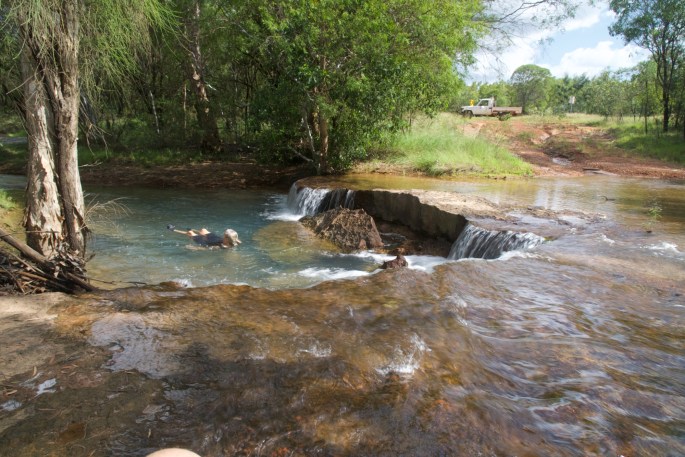

The river came up over the bridge again on 27th March, only 710mm over this time, but still enough to cut the bridge to traffic, with it’s fast flow out in the middle & the increased amount of debris, flowing down, some well large enough to knock a car off the bridge. Schramm Creek cut the road north of us & Drome creek was flowing nicely creating a lovely little croc free water hole we visited a few times to cool off in. It was 10 days before the water dropped below the bridge again, even though Schramm was going up & down like a yoyo, with it’s separate catchment. More than once we had a small community of travellers camped down by the bridge having crossed the Schramm & found the Wenlock un crossable, only to turn back finding the Schramm had risen again, trapping them. Some anxieties about needing to get back for work etc but generally creating mini communities, the memories of which will no doubt linger long after they got home. Unwanted at the time, but instigators of camaraderie. For us it was novel having ‘close neighbours’ now & then.These were the times when the public phone was a free of charge lifeline to these folk.

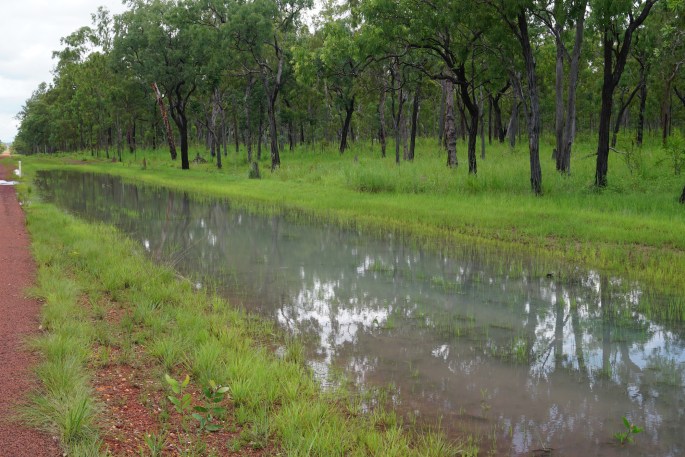


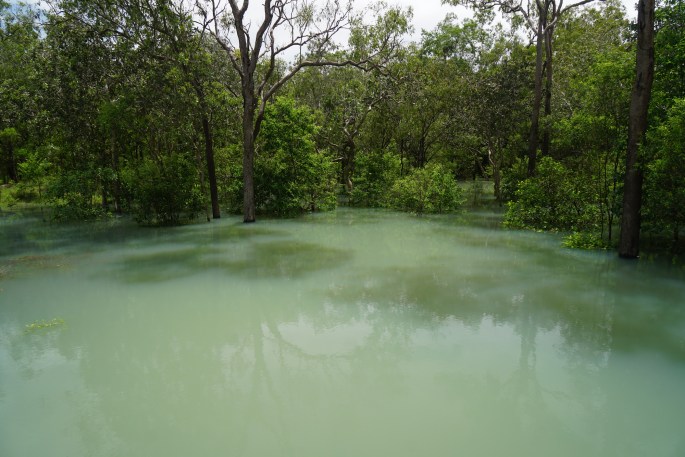
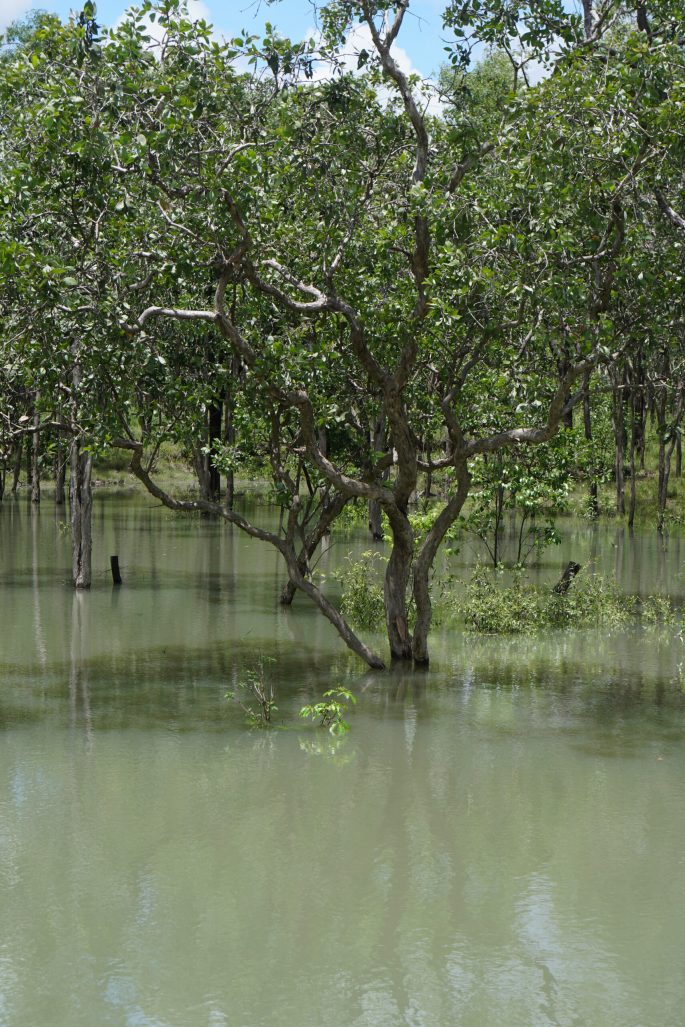
On the 18th of April, Mike, Moreton’s owner, & a couple of new seasonal staff, Sonya & Gavin arrived. We had known they were coming, a bit late having been delayed further south by the Archer River rising. We expected to spend a couple of days ‘handing over’ to them before we departed on the 20th. Within less than two hours of their arrival the bridge was once again under water. There had been significant rainfall in the still soaked catchment to our south east. Even though there was a lot of water sitting in the forests we had felt that once again we had missed out on a ‘proper’ wet season. Rainfall totals had been nothing like those down south (which were not usual). Over the next 24 hours we got 86mm of rain – the record at Moreton during our time there. However over a period of 3 days Lockhart River Community to our east received more than 500mm of rain, & much of this passed westward, slowly over the Wenlock’s catchment. The river which had dropped to around 4.5 metres rose fast, faster than we had previously experienced.
On 20th April, leaving was an impossibility, it was decided to move everything that could be moved to higher ground as a precaution again, except this was a decision based on others experience, unlike previous occasions when we had done the same, just in case. By this time the river had risen to 12.1 metres, Drome creek was well and truly backed & over the road & the furthest we could now drive off the property was about 300 metres to the north & zero metres to the south.
On 21st April the River was at 13.6 metres – exactly 7 metres over the bridge – so now there was more water height over the 6.6m bridge than under it, but what impressed most was not the depth but the hugely expanded width of the river. We could no longer see the other side as the waters edge was now around a corner in the road, The water across the road was calm & smooth, but in the distance, out in the middle of the river it was moving like a steam train. Walking away from the river up the road & around the corner we came across a ‘sea’ where once the road had been. Water several metres deep as far as we could see where Drome creek was flowing over the road & into the the forests surrounding Moreton. The lower section of the airstrip was well under water. In the 15 or so acres that is the camp ground & house site the water was creeping, slowly out of the forest, between us & the area of higher ground where all the vehicles had been taken. By late morning it was too deep to drive through & spreading ever wider.
.
On 22nd April the river peaked at 14.87metres, just below the height at which it breaks it’s banks, but the flow from east to west through the forests from Drome had continued unabated. We all watched on wondering whether we would need the boat, the water creeping toward the house & other buildings. Around us the view was transformed. Instead of looking at a forest , we were now looking at trees growing out of a huge lake. The grass, up to several feet high & undergrowth had ceased being a swirling mass & were now completely submerged. The only movement now was the flow of the water. It was a fascinating & eerie sight. Sunlight normally absorbed by the forest floor was reflected back by the water’s surface creating a beautifully stark empty look to the forest. Just trees! As the water continued spreading toward us, water birds – Egrets & Herons arrived in increasing numbers, presumably word having got around that the edge of the encroaching waters was a good place to get a feed of escaping insects, lizards etc. A couple of whistling kites took up residence in the trees, frequently swooping to grab small bug sized floating delicacies & returning to a high place to eat before swooping again. It was like all of this was happening in slow motion…. because that is precisely what was happening. No tidal waves, no Tsunami like water, but unstoppable nevertheless.
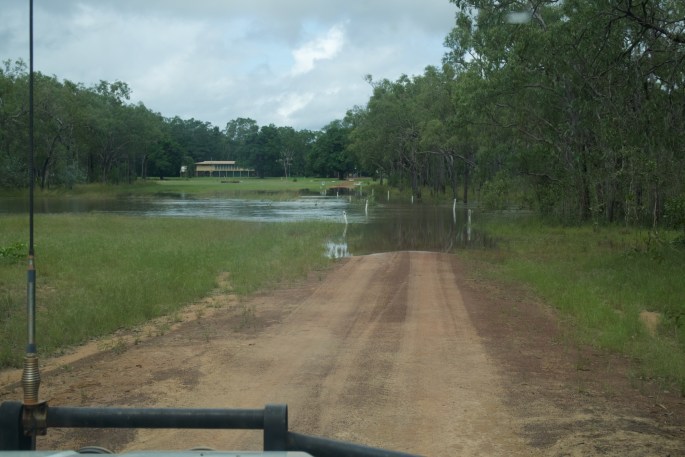




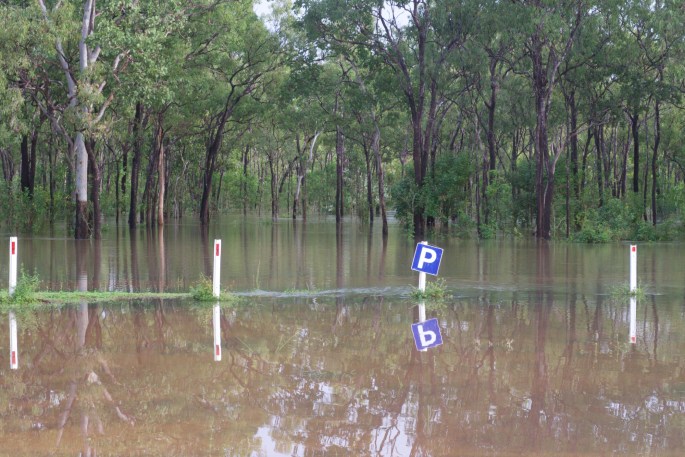
The water reached the central driveway, halfway across the campground, & perhaps 50 metres from the house at it’s closest. Later, walks in the forest showed muddy leaves a couple of metres off the ground. It was very obvious that the original builders of the property had been familiar with the both the lay of the land & the behaviour of local watercourses back in the days before laser levels. The perspective by eye makes determining where the high points are difficult, & having the buildings along the top of the river bank doesn’t make a lot of sense until you realise that most of the water ingress occurs before the riverbank height is exceeded doesn’t actually come from the Wenlock.
So we got what we had hoped to see, but without getting our feet wet. And the forest will have loved it. What is incredible is just how easily this country copes with these sort of events. With the grass under water for days (The bridge became crossable again on the 29th & the ‘inland sea’ left as fast as it had arrived) you might expect the ground to be sloppy & wet for a while, but not so. Even as the water receded we could walk the waters edge & it was firm. By the time the water had gone, there was nothing to clean up. It was clean. Just a few tyres used as markers to delineate sides of the roads had floated away & needed retrieving. Other than that you wouldn’t have known the water had been there without walking through the forest & seeing the ‘tide mark’ on bushes & trees.
A few days later I was mowing the grass again. Yep we still couldn’t leave even though the bridge was now drive-able once again!
What was now stopping us was the very same river, 100kms or so away closer to it’s head waters in the hills, & another, the Pascoe River, both of which cross the road we needed to use to get to our next destination at Lockhart River Community!
Whilst in waiting mode we had a quiet little celebration. Our 40th wedding anniversary, celebrated not with a meal out with all the works, but with two chocolate bars MrsTea had been hiding, a ‘Picnic’ for me & a ‘Boost’ for her. I also replaced the wedding ring I had to hacksaw off her finger 18 months earlier, a long way from anywhere when her finger swelled up. We bought a small plastic ‘finger measurer’ online, followed by an approved (by her) gold ring.
The Pascoe could be monitored – sort of – on the internet. There is an auto monitoring station quite a few kilometres downstream of the crossing. Not accurate heights for the crossing itself , but a ‘relative indicator’ & we were able to extrapolate from a personal report at the rivers edge (thanks Neale) & the monitoring station reading at that time. The Wenlock was an unknown quantity, but reputedly a more ‘difficult’ (whatever that meant) crossing than the Pascoe. We knew both were up because the ABC national news had reported two groups, a total of 40 people & multiple cars becoming stranded between the two. It turned out they were stranded for more than two weeks, requiring some to be airlifted out by helicopter, & the rest having supplies dropped into them. It was a frustrating time for us, we had loved our time at Moreton, but now we were ready to leave. ‘Our’ solitude was now a hive of busy activity preparing for the imminent start of the tourist season. We helped out as we could, putting up safari tents, retrieving dismantled bed frames from the sea containers in which they had been stored since the end of last season & putting them back together, bedding etc, cleaning away the wet season making way for place folk love on their ‘trips of a lifetime. We even started seeing the first guests arrive. A motorcycle tour group. 15 bikes & riders plus support trucks. We couldn’t help feel the loss of our solitude, & we had somewhere else to be, but leaving made no sense until we knew we could reach our destination. The days dragged on & eventually we left on a spur of the moment decision after lunch on the 8th May. Phone calls & the Cape network seemed to suggest that a few folk had been able to cross the Wenlock & Pascoe, but it had been falling *very* slowly’ – but now there was a potential for a bit more rain out along the east coast forecast, which if it happened we felt sure would prevent us from getting to Lockhart for at least a further couple of weeks, so we took a punt, with assurances that if we couldn’t get through we could return to Moreton. Our plan hatched over a 15 minute discussion was that we drive the 100+kms to the first of the two rivers, the Wenlock & camp, waiting to watch whether anyone else crossed – but it didn’t quite pan out like that.
For those of you who love birds & whose eyes don’t glaze over when lists of birds are included in our blogs here is the final list of bird species we identified whilst at Moreton. There were of course more that we heard or even saw that we couldn’t positively identify. Our final total was was 64 bird species plus ‘critters’. .
Moreton Bird List
Yellow Oriole
Hornbill Friarbird
White-bellied Cuckoo-Shrike
Black-faced Cuckoo-shrike
Blue-faced Honeyeater
Palm Cockatoo
Channel-billed Cuckoo
Bar-Shouldered Dove
Wompoo Pigeon
Magnificent Riflebird
Eastern Koel
Laughing Kookaburra
Rainbow Lorikeet
Large billed Gerygone
Australian Bustard
Brush-turkey
Spangled Drongo
Bush Stone-curlew
Green Pygmy Geese
Pied Cormorant
Australian Darter
Yellow Spotted Honeyeater
Orange-footed Scrub fowl
White Bellied Sea-eagle
Great Bowerbird
White -throated Honeyeater
Yellow Honeyeater
Trumpet Manucode
Magpie Lark
Torresian crow
Red-browed Finch
Great Egret
Brown-backed Honey eater
Lemon-bellied Flycatcher
Pheasant Coucal
Sulphur-Crested Cockatoo
Whistling Kite
Tawny-breasted Honeyeater (lifer)
Rufous Shrike-thrush (aka Little Shrike-thrush).
Masked Lapwing
Pied Butcherbird
Sarus Crane
Frigatebird
Red-winged Parrot
Brown Falcon
Leaden Flycatcher
Black Butcherbird (Adult feeding young bird)
Yellow-billed Kingfisher (heard, not seen).
Black-backed Butcherbird
Little Friarbird
Red-backed Fairywren
Papuan Frogmouth (lifer)
Pale-headed Rosella
Brolga
Brush Cuckoo (not seen, but heard daily at dawn).
Boobook Owl
Wedge-tailed Eagles (pair)
Brown Falcon (Light Morph, juvenile, harassing Lapwings & brush turkey, & then trying to catch flying insects)
Forest Kingfisher
Rainbow Bee-Eaters (a flock of 40 or 50 flew over in early morning)
Striated Heron
White-faced Heron
Dollarbird
Pied Heron
Other Critters
Wild Pigs & Cattle
Frill Necked Lizard
Dingos & pups
Small Goanna
Goulds Goanna
Keelback (Black backed northern variety)
Western carpet python.
Geckos
Small lizards
Driving down the road from Moreton, the bitumen seal finished after a couple of kilometres becoming a red dirt road with multiple small water crossings & huge amounts of water sitting in the forests on both sides of the road. It felt different. It was different, the first time we had been this far from Moreton in over 6 months since we had driven the car to Weipa for repairs last October. On the whole the road had held up well to the wet season, mostly it wasn’t the sloppy mess we had expected. Mainly easy driving, but slow because of the frequent need to slow to first gear to cross washouts etc. The rain was on & off, sometimes light, sometime briefly heavy’ish, high speed on the windscreen wipers was sufficient though. It felt like every drop of rain was conspiring against us, filling the rivers we wanted to cross. We pressed on with fingers crossed. By the time we reached the Wenlock crossing the only clouds were fluffy & white, the sky was blue & the rain had stopped & our optimism had grown, but still we were driven by the desire to be past these two watery hurdles – well at least I was. A couple of kms before the Wenlock we met a truck & a 4wd coming the other way, obviously having crossed both rivers. We stopped for an exchange of info. They could see what we were driving & towing & assured us we’d get across ok, but advised that although there was a lot of sand deposited on the Pascoe crossing that provided we had road pressures in our tyres that when we hit the sand it would feel ‘doughy’ but to keep going & the tyres would cut through the soft sand to the concrete surface below.
At the Wenlock, it looked a long way to the other side. MrsTea walked it as I watched her – the water reaching to the very top of her legs, with only a very gentle current. 800mm deep. Deeper than anything we have previously driven though, but buoyed by the the folks report I decided to give it a go, besides MrsTea wasn’t going to walk back!
I fixed a tarp across the front of the car to help maintain a bow wave without filling the engine compartment & taped up the rear canopy doors to prevent any chance of water getting in. Took a deep breath & proceeded forward into the water, hoping the Tvan behind wouldn’t float. Such a shame we have no footage or photos of me driving across. Understandably MrsTea was reluctant to take a camera or ipad through the water with her. With the exhaust pipe well & truly under water there was a sense of quietness in the water which accentuated the echo-ey sound of the water lapping half way up the doors. It was a text book crossing & quite straightforward , giving me increased confidence for the Pascoe crossing 20kms or so later.
We repeated the successful formula at the Pascoe. MrsTea walked it & it was the same height that the Wenlock had been, confirmed by MrsTea’s wet line & a level marker showing 800mm. As she waded through she pointed vigorously toward where her feet must have been, stumbling as she did so several times. I thought she was pointing out rocks washed onto the concrete base when the water had been close to 14 metres deep recently. In hindsight we should have used our handheld UHF radios, because we couldn’t hear each other above the noise of the water which was flowing noticeably faster than the Wenlock had been. It turned out that it was the soft sinky sand she was stumbling in , not rocks. Knowing where she had walked & thinking it was rocks, & bearing the speed of the flow in mind I judged it best to keep to the right of the crossing, on the upstream side. This, as it turned out was not one of my better judgements, which became scarily apparent when 20 metres from the exit, water more than half way up the driver’s door, lots more echo-ey noises than previously, I found myself with all four wheels spinning & not going anywhere. I had already engaged the front diff lock before entering the water, but still had no traction. My mind raced, basically the same thought repeating, “in water you need to keep moving, stopping is disastrous”. On mud, in similar ‘failure to proceed’ situations swinging the steering wheel from side to side can gain just enough traction to keep moving forward – sometimes. I couldn’t think of anything else to do, so did that ….. & it worked ….just! Inching forward at snails pace, whilst wondering if I’d make is not something I am keen to repeat in the future. I made it, & the look of relief on MrsTea’s face said it all. She thought I’d had it, just as I did. Of course what I should have done was driven on the left of the crossing, the downstream side where the depth of the sand deposits would have been less making the crossing far more straightforward, but the possibility of the current pushing me off the crossing had me spooked. Lesson learned.
It was with relief that we drove up the hill away from the water looking for a spot to spend the night as darkness was falling. We both felt thankful we had managed the two crossings & were still dry inside the cab. At least we thought we were – 2 days later the smell told us otherwise, but we did get away without needing a total strip of the cab. Only the drivers side footwell was wet – the sound proofing felt underneath the vinyl flooring was sodden. One seat out, a clean of 5 years worth of outback dust which had become slime, & several days of an electric fan directed onto the lifted section of flooring sorted it. Finding where the water got in was difficult. The drivers side door seal was no.1 suspect, but proved to be innocent, The culprit as it turned out – a little plastic ‘receiver for a corresponding fastener which holds a section of plastic trim in place across the door sill, sits in the floor pan, protruding slightly below it, must have been hit with a rock or something somewhere. It had a hole in it. A $2 item.
And so the next morning we reached our destination in the rain forest, our new ‘home’ for the next 12 months. It had been an interesting journey, dominated by those two rivers. There were other river crossings , in fact we gave up counting, but in the 190kms drive we had crossed more than 70 lots of flowing water, mostly ‘natural’ (non concrete) crossings, but it is those two concrete crossings which we’ll remember. In a few weeks when the tourist season picks up, most of the crossings will be dry & folk will likely not even notice they are passing over a crossing, Only a handful will continue to run all year. This was our third drive up that road, but the first when it was wet it & it was hardly recognisable. All the works which have been undertaken by the road gangs from Lockhart River Council became very noticeable in so much we could appreciate how much difference their work has made to the journey. In the dry we wouldn’t have given that a thought.
We turned off the Lockhart road, into the rainforest, up a steep hidden driveway flanked by thick rainforest, several hundred metres long & arrived at our new ‘home’. The folk we were taking over the caretaking from, John & Mez whom we were yet to meet were out & so our initial impressions of the place formed during a walk around, not feeling comfortable to enter. Our fault they hadn’t known to expect us. Nevertheless our first impressions were such that we kept smiling & exclaiming what a wonderful place it was.
We would love to show you photos & I think you would immediately understand why we felt as we did, but the owners, prior to us making an agreement about coming here, requested that we post no photos of the house & other infrastructure, nor any info which might help others to locate the place. We agreed to that.
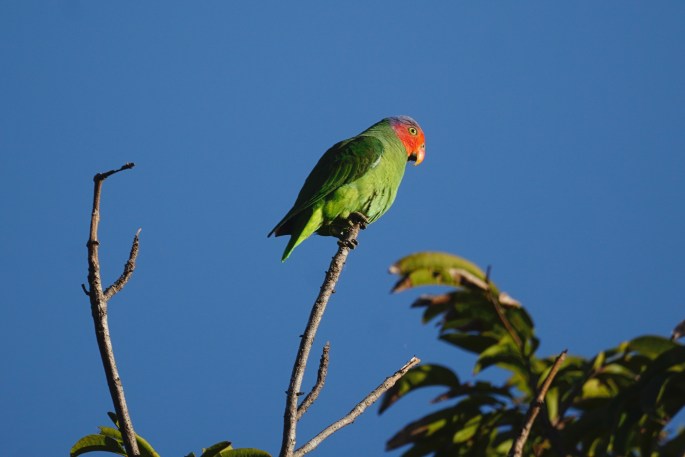
First up we are surrounded by the Iron Range rainforest, 800 acres of it, which in turn is surrounded by more Iron Range rainforest which is the National Park. It is called Iron Range because it is a rainforest covering a low mountain range of that name. We are close to it’s southern limits. So this is an area of dense ‘jungle’ with several permanent rivers & many seasonal creeks across steep mountainous terrain, making most of it virtually inaccessible to humans without destructive machinery. Back in the gold rush days there were a few mines, largely accessed, I suppose, by narrow hand cut paths. In World War two the property we are now on was pretty much cleared by American forces & their allies, and we are told there are still bunkers & latrines etc to be found where the forest has taken it’s own back. etc. To look at our new surroundings with it’s enormously varied dense undergrowth & towering trees you would never know large parts of it had been cleared 75 years ago. Not too far away there are trees that are centuries old. For anyone unaware of this rainforest, it is quite unique, with many species of flora & fauna which exist only here & others which either visit annually from Papua New Guinea or exist in both locations. Much remains unknown about this remote rainforest & is thus the reason for this place we will be calling home. The Iron Range Research Station. A philanthropic project to provide accommodation for researchers interested in furthering knowledge of this ‘jungle’. One of those rare pockets of the earth still to be discovered & we hope, preserved. It is also a bucket list destination for every Australian birder as well as many from overseas. The house is fairly new, almost 7 years old & very nicely appointed, the strongest first impression being about how thoughtfully it has been designed with aesthetics as well as comfort & practicality immediately noticeable. This in itself probably makes it also unique on the Cape where building anything is harder than most places because of distance, climate & access, making getting building materials here a challenge. Thus basic & practical is more common. Two buildings side by side, one with two bedrooms each with ensuites, & the other with 3 bedrooms, one with an ensuite & the other two with their own shared facilities. In the second building is a large comfortable sitting room/meeting room with wall length concertina doors opening out onto a veranda & the rainforest 2 or 3 metres away on two sides. Between the two buildings is a very pleasing to the eye, practical & comfortable outdoor cooking & dining area, all under cover of course with a smooth painted concrete barefoot friendly floor. A kitchen prep & storage room sits alongside the outdoor kitchen with room length concertina windows like a huge servery. At night this is shut & critter proof. The place operates completely off grid with it’s own water bore (lovely water) & solar power system. Elsewhere on the property are a couple of out buildings providing a workshop (with it’s own solar power system) and another storage facility. A number of tracks through what is otherwise very dense rainforest exist through the property but we are yet to fully explore them, some having become overgrown, but which we hope may be machinery-cleared a bit later during the year. Being on a hillside, our leg muscles will get more of a workout than they have been used to, but there is a 4wd side by side ‘buggy’ for when things need to be carried or our knees say no.

During our first 3 days the birds we observed, mainly just sitting at the central dining table, were interesting, including 3 new species which were first timers ever for us (‘Lifers’ in bird nerd parlance) – one we hadn’t even known existed. No photos though as I decided that should wait until the humidity dropped before getting out the camera in order to avoid damage to lenses. The 3 ‘Lifers’ were: our very first sighting of the gorgeous Yellow-billed Kingfisher who’s calls we had heard at Moreton, but never seen, Red-Cheeked Parrots, bright green with red faces ,white eyes & a blue toupee & who only live here – these we now see every morning, & the one we had never heard of the White-faced Robin which also only exists on the northern-most east coast of Cape York. A bright yellow chested bird with a black head & the most comical white face. It really is quite clown-like. Hopefully I will build a collection of bird photos, beginning soon. Humidity has dropped & the camera came out this morning.
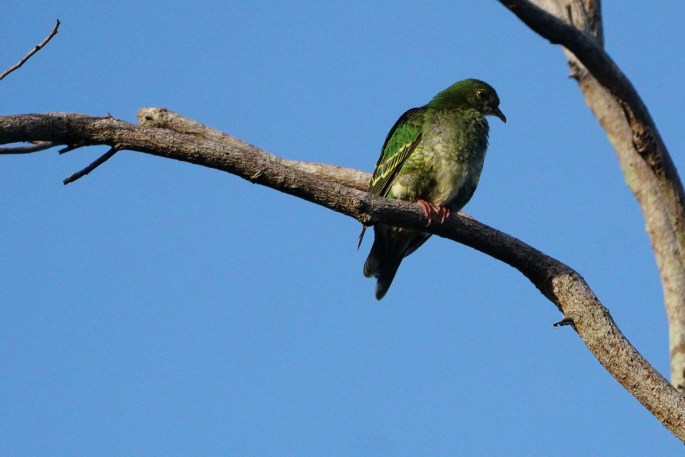

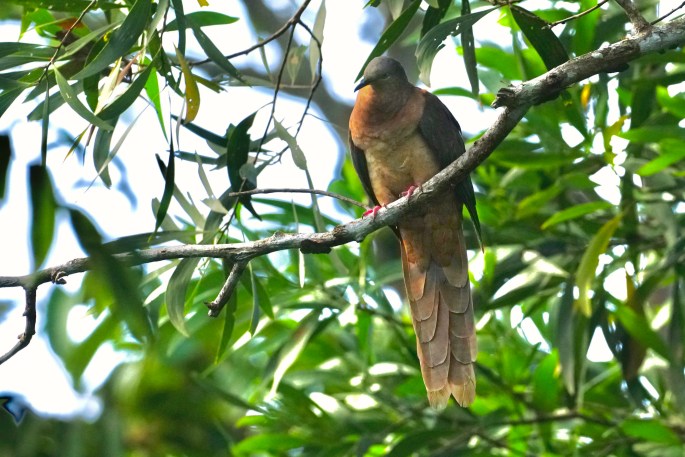
The bird list here so far (after 2 weeks) is:
Wompoo Fruit Dove
Brown Cuckoo-dove
Red Cheeked Parrots (Lifer)
Sulphur Crested Cockatoo.
Bar-Shouldered Dove
Magnificent Riflebird (heard only)
White-throated Honeyeater
Yellow-spotted Honeyeater
Pacific Emerald Dove
Tawny-breasted Honeyeater
White-streaked Honeyeater
Red-tailed Black Cockatoo
White-faced Robin (Lifer)
Eclectus Parrots (male & female)
Little Shrike-thrush
Brush Turkey
Palm Cockatoo
Yellow-billed Kingfisher (lifer) – male
Frill-necked Monarch
Dusky Honeyeater
Rufous Fantail
Orange footed Scrubfowl
Spectacled Monarch
Black Butcherbird
Australasian Figbird
Superb Fruit Dove (female)
Double eyed Fig-parrots
Critters
Huge Golden Orb weaving Spiders
Northern Tree snake
Green tree Python.
Dingo
& ‘Nina’ – Bare-backed Fruit-bat – visits nightly.
White-lipped Green Tree Frogs. – Always around, a daily morning activity ‘where are the frogs going to hang out today’. Highest score so far was for the one who spent the day on the top rim of a pedestal fan.
We saw the first Green Tree Python on our first night here, just a couple of metres from the veranda, & a second a few nights later. Nina is a large Bare-backed Fruit bat raised by a previous caretaker, & released back into the forest, who visits most nights for a treat of a piece of fruit put out for her. She sulks if the fruit is not there & goes to hang upside down on the kitchen ceiling fan, or flaps around us at close quarters , which can feel a bit intimidating. The Dingo strolled past our bedroom door one morning, sat & watched, whilst laid in bed & watched it. It wandered away casually (as dingos do), out of sight when a Brush turkey came on the scene. We watched on thinking the turkey might be breakfast, but Mr Dingo had left & the turkey totally unaware that where he was scratching the ground a Dingo had sat just moments earlier.
John & Mez were great, before leaving they took us out to show us nesting sites for a variety of birds, & we even discovered a previously unknown nesting or roosting site for Eclectus Parrots & Double eyed Fig parrots – one tree had two pairs of Eclectus & around 40 Double eyed fig parrots.These are highly desirable sightings for the birding fraternity. This rainforest is the only place in Australia where Eclectus live. Other highly desirables are the Yellow billed Kingfisher, & Buff breasted Paradise Kingfisher, both of which nest within a few steps of the house, in holes they make in termite mounds. Their dainty little heads & bills belie their toughness, as they fly at the mound again & again to batter through the sun hardened crust to then excavate a burrow to nest in. The BBPK in ground based termite mounds & the YBK in termite mounds higher up on the side of tree trunks. The Papuan or (Red bellied) Pitta, is probably the rarest & most elusive ’target’, but we’ll have to wait until later in year for that special little beauty with the ghostly voice to arrive from PNG.
There are a few downsides to living here too as you might expect. The first a discovery, had no idea they existed. John took me for a walk to a hidden but beautiful set of waterfalls on the Claudie River, a site known only to locals, & one where Tarzan swinging in on the end of a vine, his chest beating & yodel like call echoing down over the falls would not seem out of place. The discovery of the existence of ‘Chiggers’ was not quite so impressive. Turns our that these are mites (of several varieties) which live on the forest floor and in decaying logs. There were plenty of fallen moss covered trees, hiding these nasty microscopic little buggers, to scramble over on the narrow handcut path to the falls. They latch onto passing any animals (including humans) who make contact. Resulting large very itchy welts, commonly in places where you least want such things, & if not treated in a timely manner can spread around the body. Thankfully John & Mez were still here & identified that I had a dose of ‘Scrub Itch’. A well stocked first aid cabinet had a tube of Scabies Cream in it & which I decided would be worth a try. A return walk to the falls is on the cards though, so we’ll have to work out a prevention strategy.
Other downsides are the innocuous looking Iron Range Stinging tree, like the stinging nettles (of my English childhood) on steroids. Instant pain for which for opiates are prescribed, & ongoing disturbing & painful effects for several months afterwards. A single touch is all it takes. They can even sting through clothing & dead leaves on the ground are just as nasty as live ones. Trouble is there are so many other harmless plants which look very similar. A new walking skill is needed in the rainforest. We need to train ourselves not only to watch where we are walking to avoid tripping over vines,& rocks etc, or standing on snakes, now we have to have whole body awareness. Likewise for the Iron Range version of ‘Wait-a-while’, a vicious looking plant with barbs that grab you & fine hairs that pierce your skin & break off, causing extreme misery – but at least it’s easy to recognise.




We might be a long way from anywhere, but we still managed to vote in our General election. One reader here will likely recall writing on Facebook that it was the first time the person & party he voted for won. Me too! We hope they honour their promise to follow the ‘Uluru Statement From the Heart’ and establish what is needed for constitutional change to give Aboriginal Australians a true voice in their own country, as well as working to provide a more caring, compassionate & people first government who will be serious about tackling climate change.


We are looking forward to all the discoveries to come, to observing the changes that seasons bring that being in this place for a full 12 month cycle will allow.
Thanks again to every one of you who reads this, & especially to those of you who are kind enough to share your thoughts with us. This post has been a long time coming, it seems harder to write when not on the move. We have enjoyed being stationary, if we hadn’t we wouldn’t have committed to following up Moreton with an even longer stationary stay here, but without something new to write about regularly, it’s easy to let things go. And doing that makes getting started again harder. I’ll try to write more often whilst here, maybe short & sweet – but we’ll see.
Regards Cuppa & MrsTea.


Great read and photos.
Good to meet you both.
Great read as usual. We camped close to the Telstra phone box in July last year. It’s hard to comprehend how much water must flow through there during the wet season.
Love your blog, it’s been a long but worth while wait for this instalment. Thank you!
A beautiful story.Cuppa and Mrs Tea
From the sunshine and clear blue skies of korumburra, south gippsland, reading your blog transports me to your place. The heat, humidity, of fnq, the thick rainforest and what i imagine the bird call, the thrill of ‘lifies’ bird spotting…a magical read. Thank you for your words and excellent photos…yes please keep writing.. love the adventures. Thanks
Thanks, such an interesting blog, 1st time read for me, my husband and I went to the Cape in 2003❤
Another fascinating read. We love your narrative and bird pics and we
really look forward to the next episode. Wishing you many more happy and safe travels.
Great story Cuppa, we thought that you had forgotten us.
No Peter, just spent longer than usual procrastinating before finally getting around to posting again! 🙂
Chiggers!!!
Been there done that..
But the rest of the place sounds worth it
Great to hear that all is still going well. Love and envious of hearing of your journey. Keep safe.
Wonderful life guys that only makes the reader very envious. Keep enjoying it. Brian Murphy – BONZA
Thanks for reminding us of all the things we love about Moreton. Haven’t lived through the wet, but have worked 2 sessions at the beginning and middle of the tourist season and dealt with most of the above.
Another great read that leaves us hoping the next instalment of your adventure is not too far away.
Ian and Mrs T, Thankyou so much for your great insights and explanations of your ongoing adventures. So excited for you to be seeing such wonderful bird life. I look forward to your posts and hang on every word, waiting for the outcome of some of your ‘incidents’. Your time on the Cape has become meaningful as we will be visiting the area in August, along with the thousands of other nomads and tourists. Glad to see you have your very private rainforest retreat, so shouldn’t be too affected by those coming up from the south to gain a taste of paradise.
I look forward to next update. Take care and enjoy.